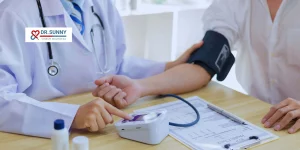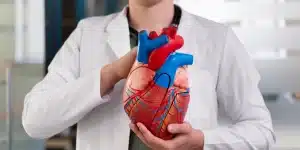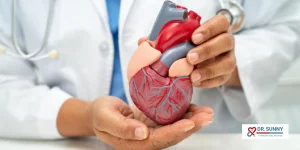As a cardiologist practicing in the Greater Toronto Area, including Brampton, Mississauga, Caledon, and Milton, Ontario, one of the conditions I frequently encounter is Postural Orthostatic Tachycardia Syndrome (POTS). This relatively underdiagnosed and often misunderstood condition can cause a range of distressing symptoms, such as dizziness, palpitations, shortness of breath, and chest pain.
Understanding POTS, its symptoms, causes, and available treatments, can help individuals living in these areas who may be struggling with these symptoms but are unsure of the underlying cause. If you’ve been experiencing dizziness upon standing, palpitations, or episodes of shortness of breath, visiting a heart doctor near me or a cardiologist doctor near me could help with early diagnosis and management.
What is Postural Orthostatic Tachycardia Syndrome (POTS)?
Postural Orthostatic Tachycardia Syndrome is a condition that affects the autonomic nervous system, leading to abnormal increases in heart rate when transitioning from a lying or sitting position to standing. This abnormality causes insufficient blood flow to the brain and other organs, which results in various symptoms, including dizziness, lightheadedness, and even fainting. POTS is classified as a form of dysautonomia, meaning it involves dysfunction of the autonomic nervous system, which regulates involuntary bodily functions such as blood pressure, heart rate, and digestion.
While it may seem like a rare condition, POTS is more common than many realize, and people with this syndrome often go undiagnosed for extended periods. It’s important to consult a cardiologist if you experience any of the common symptoms, especially if they disrupt your daily activities.
Symptoms of POTS
The hallmark symptom of POTS is an abnormal increase in heart rate when standing up from a seated or lying position. This rapid heart rate is often accompanied by a variety of other symptoms, such as:
- Dizziness or lightheadedness when standing
- Palpitations (an irregular or racing heart)
- Shortness of breath upon exertion
- Chest pain, which may mimic heart-related conditions
- Fatigue, brain fog, or difficulty concentrating (sometimes referred to as “POTS fog”)
- Syncope (fainting) or near-fainting episodes
These symptoms can significantly impact daily life, making even routine activities such as standing up or walking more difficult. If you have experienced these symptoms, especially in combination, it’s crucial to seek guidance from a heart doctor or cardiologist Brampton to rule out other conditions and confirm whether POTS is the underlying issue.
Causes of POTS
The exact cause of Postural Orthostatic Tachycardia Syndrome is not fully understood, and it can vary from person to person. However, several factors may contribute to the development of this condition:
- Blood Flow Abnormalities: In people with POTS, the blood flow is not effectively redistributed when moving from a lying down to a standing position. As a result, the blood pressure drops, and the heart rate increases as the body attempts to compensate for the lack of blood reaching the brain and vital organs.
- Peripheral Nervous System Dysfunction: The autonomic nervous system (ANS) may not properly regulate blood flow and heart rate, contributing to the rapid heartbeat and low blood pressure seen in POTS patients.
- Underlying Conditions: POTS can also occur as a secondary condition linked to other medical issues such as diabetes, Lyme disease, autoimmune disorders, and even viral infections like mononucleosis.
- Genetic Factors: Research has suggested that POTS may be more common in individuals with certain genetic predispositions. However, this area is still under study, and more research is needed to identify genetic markers.
- Pregnancy: Some women may develop POTS symptoms during pregnancy due to changes in circulation and hormone levels, although symptoms often improve postpartum.
Diagnosis of POTS
Diagnosing Postural Orthostatic Tachycardia Syndrome requires careful evaluation by a trained cardiologist doctor near me. There is no single test for POTS, but several diagnostic steps may be involved, including:
- Tilt Table Test: This test is the gold standard for diagnosing POTS. The patient is strapped to a table that tilts from a horizontal to a vertical position while heart rate and blood pressure are monitored. If a significant increase in heart rate occurs upon standing (more than 30 beats per minute within 10 minutes), it can confirm the diagnosis.
- Heart Rate and Blood Pressure Monitoring: Your cardiologist may take detailed measurements of your blood pressure and heart rate at different positions—lying down, sitting, and standing. Monitoring fluctuations in blood pressure and heart rate helps to identify autonomic dysfunction.
- Blood Tests: Blood tests may be performed to rule out underlying conditions such as anemia, thyroid problems, or autoimmune diseases that could contribute to symptoms similar to POTS.
- Electrocardiogram (ECG): An ECG may be used to check for irregular heart rhythms such as atrial fibrillation or atrial flutter, which can present similarly to POTS. These conditions can also cause palpitations, dizziness, and chest pain.
If you are experiencing symptoms that are consistent with POTS, scheduling an appointment with a cardiology clinic near me for an evaluation can help determine whether you have this condition or if another underlying heart or circulatory problem is at play.
Treatment Options for POTS
While there is no cure for Postural Orthostatic Tachycardia Syndrome, treatment focuses on alleviating symptoms and improving quality of life. Management strategies include:
- Dietary Changes: Increasing salt and fluid intake can help raise blood pressure and improve blood flow. A diet rich in electrolytes may also support blood volume and circulation.
- Compression Garments: Wearing compression stockings or abdominal binders can help improve blood flow and reduce the pooling of blood in the lower extremities, helping to mitigate symptoms of dizziness and shortness of breath.
- Exercise: A structured exercise program can help strengthen the circulatory system and improve blood flow. Low-impact activities like swimming, cycling, or walking can be particularly beneficial for individuals with POTS.
- Medications: Some medications may be prescribed to manage symptoms, such as:
- Beta-blockers to reduce palpitations and regulate heart rate
- Fludrocortisone to increase blood volume and improve circulation
- Midodrine to raise blood pressure
- Ivabradine to control heart rate
- Cognitive Behavioral Therapy (CBT): For some patients, managing anxiety and stress through CBT or other therapeutic approaches can help alleviate POTS symptoms.
When to See a Cardiologist
If you live in Brampton, Mississauga, Caledon, or Milton, and are experiencing symptoms of POTS, such as dizziness, chest pain, palpitations, or shortness of breath, it’s essential to consult a cardiologist Mississauga or cardiologist Brampton for proper evaluation and diagnosis. Early intervention can improve the management of this condition and prevent further complications.
Finding the best cardiologist who specializes in autonomic disorders and heart rate abnormalities can help you navigate the complex aspects of POTS and get the support you need for managing this chronic condition.
Conclusion
Postural Orthostatic Tachycardia Syndrome (POTS) can be a challenging condition to live with, but with the right diagnosis and management, most individuals can significantly improve their quality of life. Whether you’re experiencing palpitations, dizziness, or shortness of breath, seeking help from a heart doctor or cardiologist doctor near me is the first step toward understanding and managing POTS. Early intervention is key to successfully treating POTS and minimizing its impact on your life.
For more information, or if you suspect you may have POTS, consider consulting a cardiology clinic near me or a cardiologist Mississauga to begin your journey to better health.



